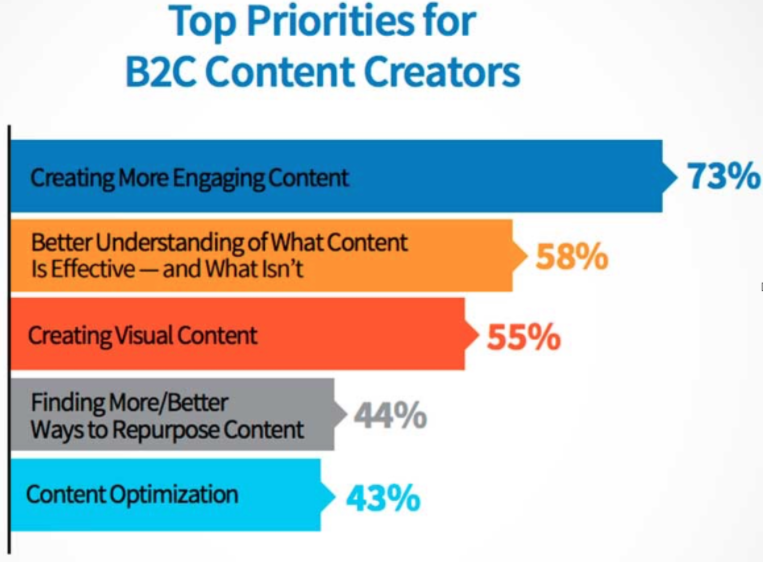Monitor the time spent on each page Website traffic is great. But just because you have high traffic, you can’t assume that your visitors are engaged with your content. People could have your page open, but they’re spending time browsing another tab on a different site. So to help you more accurately measure how long each visitor spends on a page, you should also track their scroll depth. This measures how far down the page people are scrolling. It’s safe to say that if visitors are spending time on a page and they are working their way to the bottom of the screen by scrolling, then they are engaged with your content. Just because someone clicked a share button, it doesn’t mean that they were engaged with the content. As we’ve said earlier, visiting your website alone isn’t enough to say that a visitor is engaged. But comments are a better way to measure how engaged people are. What analytics does your brand use to measure the engagement of your content?
Keep your audience engaged. Engage with your customers. Track engagement.
I’m sure you’ve heard all of this before, but what does it actually mean? It’s impossible for marketers to create engaging content without fully understanding what it is.
Clicks. Shares. Comments. Traffic. Conversions.
What counts as engagement? Well, for starters, it will depend on a few different factors. There are multiple actions that can fall within the engagement definition.
There’s a difference between the type of engagement you’ll see on your website compared to your social media pages. These numbers will look different for your email campaigns as well.
It all boils down to this. Engagement isn’t just one thing or one number. It’s a combination of factors.
With that said, marketing experts agree that creating more engaging content is a high priority for their businesses.

You need to prioritize this as well.
Fortunately, you’ve come to the right place. I can provide you with the tips, tools, and resources that you’ll need to achieve your engagement goals.
In this guide, I’ll thoroughly explain different types of engagement and how you can measure them. Once you learn how to track and manage your engagement, it will be easier for you to influence your customers.
Let’s dive in.
Monitor the time spent on each page
Website traffic is great. But just because you have high traffic, you can’t assume that your visitors are engaged with your content.
If people are only spending a few seconds on your pages, it’s safe to say that they’re not engaged. But the longer they spend on a page, the greater the chances are that they are consuming and engaging with your content.
Of course, it’s impossible to tell if someone is actually engaged just by how long they spend on the screen. For example, think about your own web browsing habits.
You may leave a browser open while you’re on the phone, texting, or just doing something else. Maybe you’re just mindlessly staring at the screen.
How many tabs do you have open right now? People could have your page open, but they’re spending time browsing another tab on a different site.
Not everyone visits a page, consumes content, and then exits. So the results of the time on the page may be slightly skewed.
So to help you more accurately measure how long each visitor spends on a page, you should also track their scroll depth. This measures how far down the page people are scrolling.
You can use the scroll map feature on Crazy Egg to track your scroll depth.
There are also WordPress plugins that can be installed to monitor these numbers.

You’ve just got to make sure that you’re running Google Analytics for this plugin to work properly.
Sure, measuring the scroll depth isn’t a perfect system either. Technically, someone could visit your site and scroll the bottom of the page in a few seconds before leaving without consuming any content. But this is probably an unlikely scenario.
It’s safe to say that if visitors are spending time on a page and they are working their way to the bottom of the screen by scrolling, then they are engaged with your content.
The time on page and scroll depth will vary based on the content of each page. For example, visitors should have a deeper scroll depth and longer time spent on a page if it’s a 3,000-word blog. But simple pages with few words and images won’t be as long.
You’ll need to keep all of this in mind when you’re measuring the results.
Comments are more important than shares and likes
As I’m sure you know, I do quite a bit of consulting with businesses. When we discuss engagement, their marketing teams are quick to talk about how many likes and shares they are getting on social media.
Don’t get me wrong, getting people to share your posts is great. User-generated content is basically free promotion for your brand.
Let’s say you share a blog post or video on Facebook. If your followers share it, then you’re getting exposure to a wider audience without having to do any extra work.
So you should always do whatever you can to promote sharing. Include social sharing icons on your website. You can even say things outright like, “Please share this with your friends.”
But with that said, high share rates don’t necessarily translate to high engagement.
In fact, research shows that there isn’t a high correlation between reading time and social sharing.

As you can see from the graph, the high read time doesn’t translate to shares. Just because someone clicked a share button, it…

COMMENTS